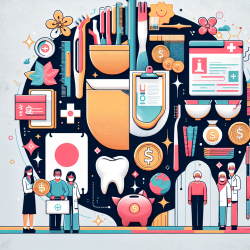Empowering Dental Practitioners: Insights from Japan's Universal Healthcare System
As the world grapples with the challenges of an aging population, Japan's universal healthcare system, particularly its dental care policies, offers valuable lessons for practitioners worldwide. The recent research article, "Comprehensive Assessment of the Universal Healthcare System in Dentistry Japan: A Retrospective Observational Study," sheds light on the factors influencing dental expenditures and provides a roadmap for enhancing dental practice in the face of demographic shifts.
Understanding the Japanese Model
Japan's healthcare system, established in 1961, is renowned for its comprehensive coverage, including dental services. The system's success is attributed to its equitable access and cost containment strategies. Dental health services are integrated into the general health service, covering more than half of dental costs for citizens. The 8020 campaign, which encourages citizens to retain 20 teeth by age 80, exemplifies Japan's proactive approach to oral health.
Key Findings from the Study
The study utilized government-provided digitized insurance claims data to identify factors associated with dental expenditures. Seven factors were analyzed: age, demographics, geography, socioeconomic status, regional wealth, the impact of the 8020 campaign, and home-visit dentistry for the elderly. The findings revealed that dental costs are significantly influenced by:
- Age: Older populations (75+) incur higher dental costs.
- Geographic Regions: Differences in dental expenditures were noted across prefectures.
- Socioeconomic Factors: Regions with higher participation in government assistance programs exhibited greater dental costs.
- Home-Visit Dentistry: Increased home visits correlate with higher dental expenditures.
Implementing Insights in Practice
For practitioners, understanding these factors can inform strategies to optimize care delivery and manage costs effectively. Consider the following approaches:
- Focus on Preventive Care: Emphasize preventive services to reduce long-term costs and improve patient outcomes.
- Leverage Data-Driven Insights: Utilize data to identify trends and tailor services to meet the needs of aging populations.
- Enhance Accessibility: Implement home-visit dentistry programs to reach elderly patients and reduce barriers to care.
- Collaborate with Local Authorities: Engage with government programs to align services with regional health policies and funding opportunities.
Encouraging Further Research
While the study provides a comprehensive overview of dental expenditures in Japan, there is a need for ongoing research to explore the impact of policy changes and emerging trends. Practitioners are encouraged to engage in research initiatives and collaborate with academic institutions to contribute to the evolving landscape of dental healthcare.
To read the original research paper, please follow this link: Comprehensive Assessment of the Universal Healthcare System in Dentistry Japan: A Retrospective Observational Study.










